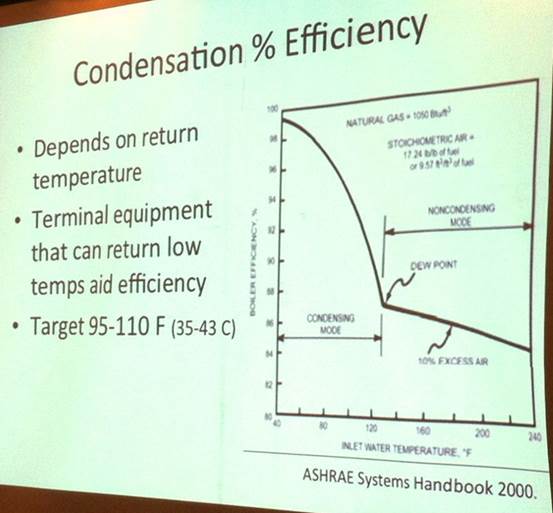Why is the boilers.idf condensing boiler curve so linear?
TLDR: The sample EnergyPlus condensing boiler curve doesn't look like a typical condensing boiler curve. Is there something wrong with it?
Samples for boiler performance curves are available in boilers.idf.
The first curve is for a "Gas-fired condensing boiler...Use curve below for a condensing boiler having a nominal thermal efficiency of 0.89" and consists of:
Curve:Biquadratic,
CondensingBoilerEff, !- Name
1.124970374, !- Coefficient1 Constant
0.014963852, !- Coefficient2 x
-0.02599835, !- Coefficient3 x**2
0.0, !- Coefficient4 y
-1.40464E-6, !- Coefficient5 y**2
-0.00153624, !- Coefficient6 x*y
0.1, !- Minimum Value of x
1.0, !- Maximum Value of x
30.0, !- Minimum Value of y
85.0; !- Maximum Value of y
In order to interpret this I looked in the EnergyPlus Input/Output Reference, section Boiler:HotWater, subsection Field: Normalized Boiler Efficiency Curve Name which indicates:
For all curve types PLR is always the x independent variable. When using 2 independent variables, the boiler outlet water temperature (Toutlet) is always the y independent variable.
Based on that I plotted several curves, expecting to see a more-or-less typical curve for a condensing boiler which would have an inflection around ~120 F. Like this one:

(from http://www.greenbuildingadvisor.com/b... )
But instead it looks like this:

The trendlines are almost exactly linear. I don't think I've made an error plotting the curve, and you can see just from inspecting the coefficients that for a PLR held constant the supply temperature terms are quite small, especially the quadratic one.
Does this data really represent a condensing boiler?






